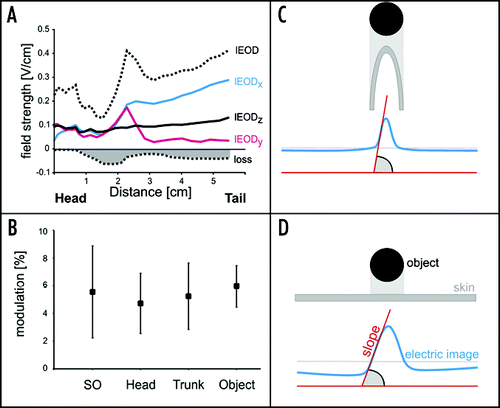Figures & data
Figure 1 The simplest form of an electric image simulated by an electrical dipole which is equivalent to a small conductive sphere.Citation26 If projected on a plane surface, the current density depends on the object's distance to the surface and on its size. The 2-D distribution of the current density is shown for a small sphere located at 1 cm (dotted line and upper image) and 1.5 cm (solid line and lower image) from the skin together with a transect through the centres of both images. Note that both peak and widths of the images are influenced by distance. The inset on the left shows an exemplary EOD of Gnathonemus petersii.

Figure 2 Properties of the local electric field (A and B) and the influence of body shape on electrical images (C and D). (A) Distribution of the three components of the local EOD (x, y and z). The summed amplitude is shown by the dotted line. The head is characterised by lEODs that are either completely in phase. In contrast, the local EOD at the trunk is less coherent. This is reflected in a loss of field strength of the lEOD as shown by the dotted line and filled area (‘loss’). (B) Modulation of the local EOD by passively bending the tail ipsilaterally by 30°. In contrast to motion of the chin appendage alone, the movement of the tail (and thus the electrical source) leads to a constant increase of the signal carrier amplitude. This modulation is in the same range as that caused by nearby objects, i.e., electrical images and re-afferent modulations can be equal in amplitude. (C and D) Schematic illustrations of the influence of the shape of the sensory surface on the electrical images projected onto them. A spherical object facing a curved sensory surface (C), for example the Schnauzenorgan, leads to an electrical image of a comparatively pointed contour. A spherical object opposite a flat sensory surface, in contrast, leads to a smoother and widened electrical image (D).
